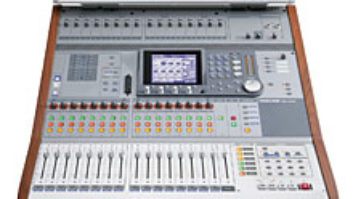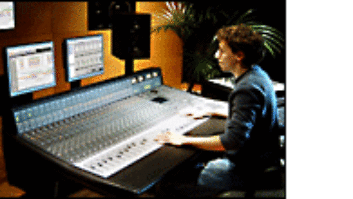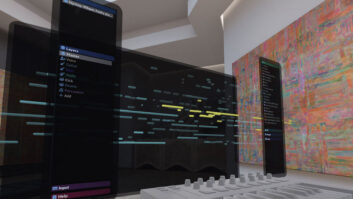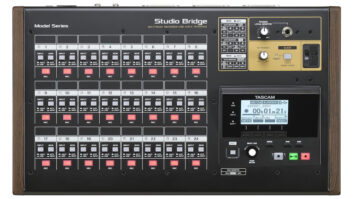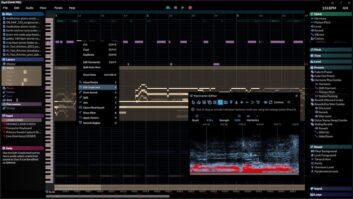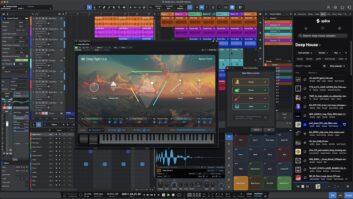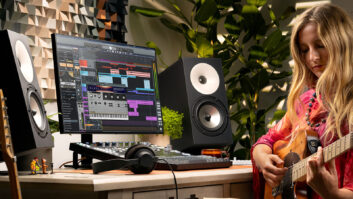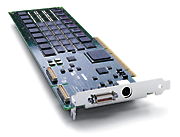

By now, even the most ardent analog holdouts have conceded that computer-based production is here to stay. And the well-tempered modern digital audio workstation can even sound pretty good. Just as hot rods and custom motorcycles are coming back — bringing high performance back to the world of stock production vehicles — interest in optimizing a digital production system’s specs and speed is revving up.
Adding some new DACs or ADCs can put some pep into an older DAW. But upgrading converters doesn’t require replacing 48 channels of I/Os. Sometimes adding a high-performance 2-channel unit — used mainly for overdubs while tracking or interfacing a couple channels of tube EQ during the mix or for routing the output bus for mixing to analog 2-track — will provide a huge quality boost at a minimal cost-per-track.
Digidesign Accel card
The more devices connected in a system — DAW or otherwise — the greater the need for a stable, external clock signal to eliminate the possibility of spurious clicks and pops, reducing jitter and boosting audio performance. And as with everything else in a studio, master clock units range from basic no-frill generators to elaborate boxes with distribution, format conversion and more. A little clocking goes a long way toward improving the sound of any digital audio system, and DAWs are far from immune to the effects of poor clock sync.
Monitor controllers (stereo or surround) and mix control surfaces simplify life for those who mix in the digital domain. There are more than a dozen monitor controllers on the market — with some incorporating elaborate control room/talkback facilities and multichannel stem busing/routing — to handle nearly any application. But for those who simply need a straight-wire approach to turning it down, the stereo NHT Pro’s Passive Volume Control (PVC) does the job with minimum fuss.
Mix controllers run the gamut from small, inexpensive fader units from JLCooper and M-Audio to large-format entries such as Digidesign’s ICON, the Smart AV Smart Console and the Euphonix System 5-MC. Blurring the lines between console and controller are systems combining full console capabilities with layers for DAW control like Yamaha’s 02R96 or Solid State Logic’s AWS 900. Of course, once you’re in this league, the word “accessory” hardly applies.
POWER AND SPEED
Add-ons may ease life in the DAW lane, but what workstation users really crave is power and speed — and lots of it. There are obvious ways to take your DAW to the next step, such as increasing RAM, adding more storage, upgrading your CPU or installing the latest (and hopefully most bug-free) version of your software and/or operating system. In terms of the latter options, sometimes the best way to go is to stick with the software rev you’ve got, unless other circumstances demand it. DAW software and the way it integrates with the CPU, OS, various plug-ins and I/O devices forms an extremely intricate, complex system where the slightest incompatibility at any link in the chain can occasionally have disastrous and extremely difficult-to-diagnose results. The old adage “if it isn’t broke, don’t fix it” certainly applies to DAWs: Waiting a month or two before installing that hot new OS or upgrade can be good advice.
The best place to begin the search to turbo-charge your DAW is with the manufacturer itself. Companies that build DSP-based hardware (non-native) workstations specialize in providing all kinds of upgrade paths for adding channels, I/O capability and signal processing punch.

TC Electronic PowerCore Compact
Designed to work with Digidesign’s Pro Tools|HD systems, the company’s $4,995 Accel card has almost twice the power of HD Process cards and four times the punch of MIX Farm cards, while dramatically increasing a system’s voice count. Accel cards support up to 192kHz operation and the TDM II architecture in Digi’s HD pack plug-in suite, as well as third-party signal processing software. Accel cards can be added to any Pro Tools|HD rig running software Version 6.2 or higher and integrates with all existing HD-compatible plug-ins, as well as TDM, HTDM, RTAS and AudioSuite formats
This OEM booster concept is not unique to Digidesign. Sonic Studio’s HDSP FX Processor adds additional channels of real-time processing to its SonicStudio HD workstation, simply as an add-on full-length card for the system’s HDSP main board. Similarly, Soundscape’s Mixpander 5 or 9 PCI cards add five or nine additional DSPs to a Soundscape DAW (Soundscape 32, Soundscape 16, R.Ed or SSHDR1-Plus) for additional mixing, effects and processing crunch with 336 internal mixing buses and 64 bidirectional audio streams between the Soundscape Mixer and the host PC.
Fairlight takes a slightly different approach with its DREAM family of DAWs, which include a suite of software processing. The company’s Plug-Ins Managers are multiprocessor cards (adding either six or 15 DSP chips) that operate within the host computer that’s running the DREAM software or on an outboard PC, thus sidestepping the need for a card cage. In addition to offering dedicated 40-bit floating-point processing, the Plug-Ins Manager cards bring support for third-party VST software to the Fairlight platform.
Even hardware-based DAWs have gotten into the act. Roland’s VS8F-3 Plug-In Effect Expansion Board is compatible with the company’s VS Series — from the top-end VS-2480DVD down to the VS-1680 — giving tens of thousands of Roland users the opportunity to upgrade their systems at any level. The VS8F-3 boasts 56-bit processing and sampling rates up to 96 kHz, depending on the V-Studio host. Each VS8F-3 can run two plug-ins; Roland includes five plug-ins with each board, and third-party developers for the platform include Antares, IK Multimedia, Universal Audio, George Massenburg Labs, McDSP and others.
NON-OEM POWER SOURCES
Outside suppliers of hardware processors for plug-ins are on the rise. Moving the CPU load off the computer and onto auxiliary DSP not only provides more horsepower to run more toys, but can also give users more life out of their computer and possibly put off a much-needed upgrade until some future time when faster, more powerful (and, hopefully, cheaper) machines arrive. And the auxiliary DSP hardware can later be moved onto the new computer for even more fun.

NHT Pro Passive Volume Control (PVC)
The grandpappy in this genre is Universal Audio’s award-winning UAD-1, now sold in pre-packaged bundles with the UAD-1 DSP card and a suite with up to 24 software plug-ins. This PC/Mac-compatible, short-form, 7-inch card is PCI 2.1 — compliant, supports up to 192kHz sampling and its bus mastering DMA provides zero host loading.
Supporting native processing workstations — Mac or PC — TC Electronic’s PowerCore platform offers a wide selection of plug-ins that run on inboard (PCI card) or outboard hardware to suit various production needs/styles and integrate with any VST, AudioUnits or RTAS-compatible DAW. The newest system is PowerCore PCI MkII, a much-enhanced second-generation of the company’s original PCI card and marketed in a bundle with 14 plug-ins. Designed with the laptop user in mind, PowerCore Compact combines 12 plug-ins with a small processor that communicates to the host via FireWire. For those needing more, PowerCore FireWire bundles 14 plug-ins with a larger hardware package in a single-rackspace chassis. The system has an open architecture for third-party support, and multiple units can be used for more power.
The newest hardware DSP accelerators on the block (so new they aren’t scheduled to ship in quantity until next month) are the APA32 and APA44-M from Waves. The APA32 is a one-rackspace unit, while the more powerful APA44-M is a half-rack unit that can be ganged side-by-side with a second unit, providing maximum power in a small portable package. Up to eight units can be connected to the host computer via standard 100M or 1G Ethernet cable, and can be switched or shared among several DAW workstations via a suitable V-LAN configuration. These PC/Mac-compatible units support Pro Tools 6.9, Nuendo/Cubase SX 3.0.2, Logic Pro 7.1 and Digital Performer 4.52. Both include Waves’ IR-L Convolution Reverb and Q-Clone plug-ins.
Of course, with most of these cool system boards, boosters, graphics/display cards, etc., one snag you may encounter is running out of PCI slots in your computer; you may need to budget for some kind of expansion card cage. One leading provider in this field is Magma, a company that makes one- to 13-slot PCI expander systems that support PCs and Macs. Space (at least in terms of PCI slots) is still the final frontier.
INBOARD/OUTBOARD
Two companies offer outboard hardware products that can play multiple VSTi virtual instruments or VST plug-ins simultaneously, either with a DAW or as a stand-alone unit, bringing VST to traditionally non-computer — based environments such as music performance or live sound mixing.

Solid State Logic AWS 900
The Muse Research Receptor has 16 total I/O channels split among stereo analog (balanced TRS jacks), stereo coaxial S/PDIF, four USB ports, 8-channel ADAT Lightpipe out and a convenient front panel ¼-inch hi-Z input for guitar. Parameters can be edited by plugging in an optional VGA monitor and PS/2 keyboard/mouse or from a Mac or PC connected to Receptor.
Manifold Labs’ Plugzilla ships with some 300 plug-ins and has 16 balanced XLR I/Os (+4/-10 dB, selectable), AES/EBU and S/PDIF digital I/Os, FireWire and USB ports and word clock sync. Two footswitch jacks add pedal control for virtual instruments. It includes PZView® software for connectivity to a Windows PC, Hot Knobs® parameter automation and Ethernet for direct Internet loading of presets, software updates and plug-ins.
Both systems are housed in two-rackspace boxes, feature up to 24-bit/96kHz operation and can be controlled via the front panel, MIDI or USB. Besides the advantage of reducing CPU load on a host computer while mixing, these units also open the world of VST into non-VST environments such as Pro Tools.
MORE POWER FOR (ALMOST) FREE
So far, all of the cool products mentioned in this article cost money; however, a number of affordable (meaning free) productivity boosts are available to the resourceful homebrew type who has access to another CPU — perhaps that machine you used before you upgraded to your current system. One such example is Steinberg’s VST System Link, which lets a user simultaneously take advantage of the entire CPU and storage muscle of several computers regardless of platform. By using a single bit from an audio stream as a carrier for transport and sync information, audio data can be transferred over standard digital audio cabling (i.e., ADAT Lightpipe, TDIF, AES or S/PDIF) using VST software and ASIO hardware. VST System Link is supported in current versions of Nuendo and Cubase SX/SL.
On the Apple side, the Logic Node application for Logic Pro 7 creates a distributed audio network using two Macs running OS 10.3 or 10.4, with a 1GHz G4 or faster computer designated as the master and any number of node computers (G5 recommended) providing shared processing for Logic 7. Just connect the Macs using a standard Ethernet cable (Gigabit preferred), switch on the node in the Arrange window and you’re ready to spread the CPU workload (plug-ins, virtual instruments, etc.) over several machines. The system is ideal for using a PowerBook as a sketchpad and then plugging into your main studio rig and continue working, but with a huge horsepower increase.

Steinberg VST System Link
Wormhole2 from Plasq allows routing audio between machines on a network to take advantage of all your studio’s processing power. For example, one could dedicate a machine for complex instruments or effects and route its audio back into your DAW; move audio between a PC and a Mac for the best of both worlds or share audio between laptops onstage. Wormhole2 is available for Mac VST and AudioUnits.
Beyond adding power, the right accessories can ease the production process. And little things — such as Contour Design’s ShuttlePRO (with its programmable buttons and jog/shuttle wheel), Frontier Design’s TranzPort wireless DAW controller or simply plugging a $10 USB gooseneck lamp into your keyboard for easier typing/naming/parameter entry in a dark studio environment — can make a difference without emptying your bank account. Digital devices may not offer the adventure of recapping an input module or the joy of hearing the difference when you swap a Sylvania for a Mullard 12AX7, but with a little customizing, you can replace digital’s “one-size-fits-all” approach for a system that is tailored to the way you want to work.
George Petersen is Mix’s editorial director.

To learn more about the SSL AWS900,click here.
For more on Apple’s Logic Pro 7 and its Logic Node app,click here.
Now that you’re armed with the utmost in DAW power and speed, make it work for you with the next generation of controllers. Click here for an overview of the console/workstation interface.
